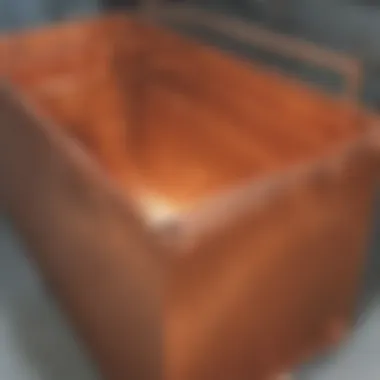Unlocking the Art of Electroplating Steel with Copper: A Comprehensive Guide


Science Fun Facts
In the realm of metallurgy, did you know that electroplating steel with copper is a process that involves the deposition of a layer of copper onto the surface of steel through an electrochemical technique? It is a fascinating method that marries the properties of these two metals, creating a synergy that enhances both the strength and aesthetics of the steel.
Discover the Wonders of Science
Dive into the captivating world of metallurgy as we unravel the complexities behind electroplating steel with copper. From understanding the principles of electroplating to exploring the ingenious applications of copper-plated steel in various industries, this guide opens doors to a realm where science and art converge to transform mundane steel into a marvel of metallurgical craftsmanship.
Science Quiz Time
Test your knowledge on electroplating steel with copper with our interactive quiz! Challenge yourself with thought-provoking questions that delve into the mechanisms of this transformative process. Sharpen your understanding of metallurgy through a fun and engaging gamified learning experience that will leave you enriched and enlightened.
Science Experiment Showcase
Embark on a hands-on journey of discovery with our science experiment showcase on electroplating. Follow step-by-step instructions to create your own mini electroplating setup, exploring the materials needed, safety precautions to be aware of, and the thrilling moment when copper magically adheres to steel, showcasing the wonders of electrochemistry in action.
Prologue to Electroplating Steel with Copper
Electroplating steel with copper is a meticulous process that holds significant importance in the realm of metallurgy and surface finishing. This technique involves depositing a layer of copper onto a steel substrate, imparting various benefits and enhancing the material's properties. The fusion of steel and copper not only improves the aesthetic appeal of the steel but also provides it with enhanced corrosion resistance and conductivity. Understanding the intricacies of this electroplating process is crucial for delving into its applications across different industries.
Understanding Electroplating
The Role of Electrolysis
Electrolysis plays a pivotal role in the electroplating process, serving as the fundamental mechanism behind the deposition of copper onto steel. Through the application of electrical current, ions from the copper electrode migrate towards the steel substrate, creating a durable and corrosion-resistant layer. The electrolysis process ensures a uniform coating, making it an indispensable aspect of electroplating steel with copper.


Principle of Electroplating
The principle of electroplating revolves around the transfer of ions from the copper electrode to the steel substrate, driven by electrochemical reactions. This principle dictates the controlled deposition of copper onto the steel surface, ensuring an even and consistent coating. While the electroplating process enhances the steel's properties, it also poses challenges such as the need for careful monitoring to prevent over-deposition or uneven coating.
Materials Required for Electroplating
Steel Substrate
The steel substrate serves as the foundation for the electroplating process, providing a robust base for the copper coating. With its inherent strength and durability, steel offers optimal adhesion for the copper layer, ensuring long-lasting performance in the final product. However, surface preparation of the steel substrate is crucial to eliminate contaminants and promote adhesion.
Copper Electrode
As the source of copper ions in the electroplating setup, the copper electrode plays a vital role in facilitating the deposition process. Its high conductivity and chemical stability make it a preferred choice for electroplating applications. The copper electrode's ability to release ions steadily ensures a consistent coating thickness, essential for achieving the desired finish on the steel.
Electrolyte Solution
The electrolyte solution serves as the medium for ion transport during electroplating, facilitating the migration of copper ions from the electrode to the steel substrate. Comprising copper sulfate and sulfuric acid, the electrolyte solution provides the necessary ions for the deposition process. However, maintaining the solution's composition and pH level is critical to ensuring efficient plating and uniform coating.
Preparation of Steel Surface
Cleaning and Degreasing
Prior to electroplating, thorough cleaning and degreasing of the steel surface are essential to remove any impurities or contaminants that could hinder adhesion. Surface cleaning processes such as alkaline cleaning and acid treatment help eliminate oils, oxides, and dirt, creating a pristine surface for optimal plating results. Effective cleaning not only promotes adhesion but also enhances the overall finish and performance of the copper-plated steel.
Activation Steps
Activation steps involve surface treatments that further promote adhesion between the steel substrate and the copper coating. Methods such as pickling or electrocleaning help activate the steel surface, increasing its receptivity to the copper ions during electroplating. Proper activation enhances adhesion strength, minimizes flaws in the coating, and ensures a uniform distribution of copper across the steel substrate.


Electroplating Process
Electroplating process is a pivotal aspect of this comprehensive guide on electroplating steel with copper. Understanding the intricacies of this process is fundamental to achieving optimal results in copper-plated steel production. The electroplating process involves the deposition of a layer of copper onto a steel substrate through electrolysis. This technique enhances the steel's properties, providing benefits such as improved corrosion resistance, enhanced aesthetic appeal, and superior conductivity. Throughout this guide, we will delve into each stage of the electroplating process, elucidating the key considerations and techniques required for successful copper plating.
Immersion in Electrolyte Solution
Evaluating Voltage and Current
Evaluating Voltage and Current play a crucial role in the electroplating process. By comprehensively analyzing the electrical parameters, operators can regulate the deposition rate and thickness of the copper layer. The voltage applied determines the speed of the electroplating reaction, while current influences the amount of copper deposited. This meticulous evaluation ensures controlled and uniform coating, essential for achieving the desired properties of copper-plated steel. The precise management of these variables is paramount for successful electroplating outcomes, highlighting the significance of voltage and current assessment in this process.
Controlled Deposition
Controlled Deposition is a key element in the electroplating process, offering a methodical approach to coat the steel substrate evenly with copper. This controlled mechanism governs the distribution of copper ions, allowing for a uniform layer thickness. By carefully controlling the deposition process, manufacturers can avoid issues such as uneven coating or excess metal buildup. The controlled deposition technique optimizes the adhesion of copper to the steel surface, enhancing the durability and functionality of the plated steel. Its systematic application ensures consistent and flawless copper plating results, making it a preferred choice in this specialized procedure.
Deionized Water Rinse
Removing Excess Electrolyte
Removing Excess Electrolyte is a critical step following the immersion in the electrolyte solution. Deionized water rinse helps eliminate any residual electrolyte from the plated steel surface, preventing unwanted reactions or residue buildup. This thorough rinsing process ensures the purity of the plated steel, reducing the risk of corrosion or aesthetic defects. By effectively removing excess electrolyte, manufacturers uphold the quality and integrity of the copper-plated steel, guaranteeing superior performance and longevity.
Drying and Finishing
Ensuring Uniformity
Ensuring Uniformity is an essential aspect of the final stages of the electroplating process. By maintaining a consistent thickness and texture across the plated surface, uniformity enhances the visual appeal and functional properties of copper-plated steel. A uniform coating promotes even conductivity and corrosion resistance, elevating the product's reliability and aesthetic value. Incorporating techniques to ensure uniformity in electroplating results in a superior finish, meeting the stringent quality standards required for various applications.
Surface Inspection


Surface Inspection serves as the concluding procedure in the electroplating process, allowing manufacturers to verify the quality and integrity of the plated surface. By meticulously examining the surface for imperfections, such as pits, scratches, or inconsistencies, operators can identify and rectify any defects that may compromise the final product. Surface inspection ensures that the copper-plated steel meets the specified standards for aesthetics and performance, certifying its suitability for diverse uses. This meticulous scrutiny guarantees that each plated steel component is flawless and ready to excel in its intended application.
Advantages of Copper-Plated Steel
The significance of delving into the advantages of copper-plated steel within this piece lies in illuminating the exceptional attributes and practicalities that this electroplating process offers. By comprehensively examining the benefits and considerations associated with copper-plated steel, one can gain profound insights into the amalgamation of steel and copper, escalating the understanding of metallurgical intricacies and enhanced surface finishing techniques.
Enhanced Corrosion Resistance
In scrutinizing the realm of enhanced corrosion resistance, focusing on the durability benefits brings forth a crucial perspective. The durability benefits of copper-plated steel accentuate its steadfast nature in withstanding environmental elements and prolonged usage. This segment accentuates the robustness embedded within the copper-plated steel structure, elevating its longevity and usability in various applications. Examining the unique feature of durability benefits sheds light on the proactive measures copper-plated steel undertakes to resist corrosion, making it a favorable choice for industries requiring enduring and resilient materials.
Improved Aesthetic Appeal
Exploring the realm of improved aesthetic appeal amplifies the visual allure and appeal of surfaces treated with copper. Diving into the intricacies of surface finish options reveals a multitude of choices available for enhancing the overall look and feel of copper-plated steel. Delving into the unique features embedded within surface finish options provides a detailed understanding of how various finishes can transform the appearance of copper-plated steel, catering to diverse preferences and applications. Investigating the advantages and disadvantages of different surface finishes offers a comprehensive evaluation of their impact on the aesthetics of copper-plated steel, presenting a holistic view of the visual enhancement potential.
Conductivity Advantages
Unpacking the conductivity advantages inherent in copper-plated steel sheds light on its vital role in electrical applications. By focusing on the electrical applications of copper-plated steel, one can appreciate its exceptional conductivity properties that make it a staple choice for various electrical components and systems. Highlighting the key characteristic of electrical applications underscores the efficiency and reliability copper-plated steel offers in conducting electricity, making it a sought-after material in industries requiring seamless electrical conductivity. Exploring the unique features of electrical applications showcases how copper-plated steel's conductivity advantages surpass conventional alternatives, solidifying its position as a top contender in the realm of electrical engineering and innovation.
Applications of Copper-Plated Steel
In this elucidative guide on electroplating steel with copper, it is paramount to delve into the applications of copper-plated steel. The significance of this topic lies in its practical implications in various industries, offering a convergence of durability, aesthetics, and functionality. By exploring the applications of copper-plated steel, we uncover a realm where corrosion resistance, visual appeal, and electrical conductivity intersect to elevate the performance and longevity of steel components.
Automotive Industry
Transcending into the automotive sector, the application of copper-plated steel manifests prominently in the production of exterior trim components. The production of exterior trim involves intricately coating steel with copper to enhance its resistance to environmental factors and improve its visual allure. The key characteristic of copper-plated exterior trim lies in its ability to withstand harsh conditions while maintaining a lustrous finish. This choice stands out due to the balance it strikes between durability and aesthetics, making it an optimal selection for automotive applications. The unique feature of copper-plated exterior trim is its ability to provide both protective and decorative functions simultaneously, contributing significantly to the overall appeal and longevity of vehicles.
Electronics Sector
Within the realm of the electronics sector, the utilization of copper-plated steel in circuit board components plays a pivotal role in enhancing conductivity and structural integrity. Circuit board components embrace copper-plated steel for its exceptional electrical conductivity, ensuring efficient transmission of signals within electronic devices. The key characteristic of using copper-plated steel in circuit board components is its superior electrical performance, making it a preferred choice for modern electronic systems. The unique feature of copper-plated circuit board components is their ability to reduce signal loss and enhance signal clarity, thereby optimizing the overall functionality and reliability of electronic devices.
Cookware Manufacturing
Transitioning to cookware manufacturing, the incorporation of copper-plated steel for heat conduction benefits revolutionizes the culinary experience. The heat conduction benefits offered by copper-plated steel in cookware amplify the efficiency of heat distribution, resulting in precise and uniform cooking. The key characteristic of utilizing copper-plated steel in cookware lies in its ability to respond rapidly to changes in temperature, facilitating even cooking without hotspots. This choice is favored for its exceptional heat conductivity, making it an ideal option for culinary enthusiasts seeking precision in their cooking endeavors. The unique feature of copper-plated steel in cookware is its capacity to enhance heat transfer efficiency, leading to superior cooking performance and delectable culinary outcomes.







